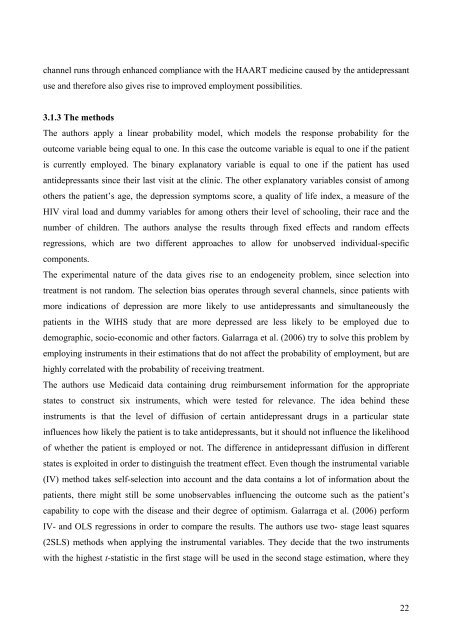An Analysis on Danish Micro Data - School of Economics and ...
An Analysis on Danish Micro Data - School of Economics and ...
An Analysis on Danish Micro Data - School of Economics and ...
Create successful ePaper yourself
Turn your PDF publications into a flip-book with our unique Google optimized e-Paper software.
channel runs through enhanced compliance with the HAART medicine caused by the antidepressant<br />
use <strong>and</strong> therefore also gives rise to improved employment possibilities.<br />
3.1.3 The methods<br />
The authors apply a linear probability model, which models the resp<strong>on</strong>se probability for the<br />
outcome variable being equal to <strong>on</strong>e. In this case the outcome variable is equal to <strong>on</strong>e if the patient<br />
is currently employed. The binary explanatory variable is equal to <strong>on</strong>e if the patient has used<br />
antidepressants since their last visit at the clinic. The other explanatory variables c<strong>on</strong>sist <strong>of</strong> am<strong>on</strong>g<br />
others the patient’s age, the depressi<strong>on</strong> symptoms score, a quality <strong>of</strong> life index, a measure <strong>of</strong> the<br />
HIV viral load <strong>and</strong> dummy variables for am<strong>on</strong>g others their level <strong>of</strong> schooling, their race <strong>and</strong> the<br />
number <strong>of</strong> children. The authors analyse the results through fixed effects <strong>and</strong> r<strong>and</strong>om effects<br />
regressi<strong>on</strong>s, which are two different approaches to allow for unobserved individual-specific<br />
comp<strong>on</strong>ents.<br />
The experimental nature <strong>of</strong> the data gives rise to an endogeneity problem, since selecti<strong>on</strong> into<br />
treatment is not r<strong>and</strong>om. The selecti<strong>on</strong> bias operates through several channels, since patients with<br />
more indicati<strong>on</strong>s <strong>of</strong> depressi<strong>on</strong> are more likely to use antidepressants <strong>and</strong> simultaneously the<br />
patients in the WIHS study that are more depressed are less likely to be employed due to<br />
demographic, socio-ec<strong>on</strong>omic <strong>and</strong> other factors. Galarraga et al. (2006) try to solve this problem by<br />
employing instruments in their estimati<strong>on</strong>s that do not affect the probability <strong>of</strong> employment, but are<br />
highly correlated with the probability <strong>of</strong> receiving treatment.<br />
The authors use Medicaid data c<strong>on</strong>taining drug reimbursement informati<strong>on</strong> for the appropriate<br />
states to c<strong>on</strong>struct six instruments, which were tested for relevance. The idea behind these<br />
instruments is that the level <strong>of</strong> diffusi<strong>on</strong> <strong>of</strong> certain antidepressant drugs in a particular state<br />
influences how likely the patient is to take antidepressants, but it should not influence the likelihood<br />
<strong>of</strong> whether the patient is employed or not. The difference in antidepressant diffusi<strong>on</strong> in different<br />
states is exploited in order to distinguish the treatment effect. Even though the instrumental variable<br />
(IV) method takes self-selecti<strong>on</strong> into account <strong>and</strong> the data c<strong>on</strong>tains a lot <strong>of</strong> informati<strong>on</strong> about the<br />
patients, there might still be some unobservables influencing the outcome such as the patient’s<br />
capability to cope with the disease <strong>and</strong> their degree <strong>of</strong> optimism. Galarraga et al. (2006) perform<br />
IV- <strong>and</strong> OLS regressi<strong>on</strong>s in order to compare the results. The authors use two- stage least squares<br />
(2SLS) methods when applying the instrumental variables. They decide that the two instruments<br />
with the highest t-statistic in the first stage will be used in the sec<strong>on</strong>d stage estimati<strong>on</strong>, where they<br />
22
















